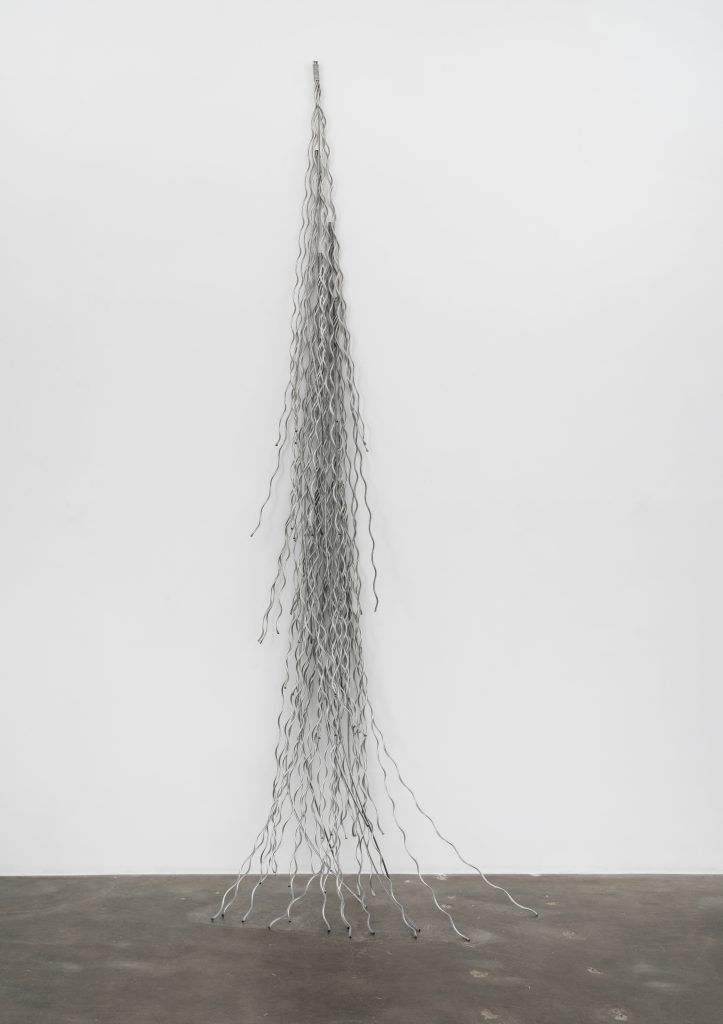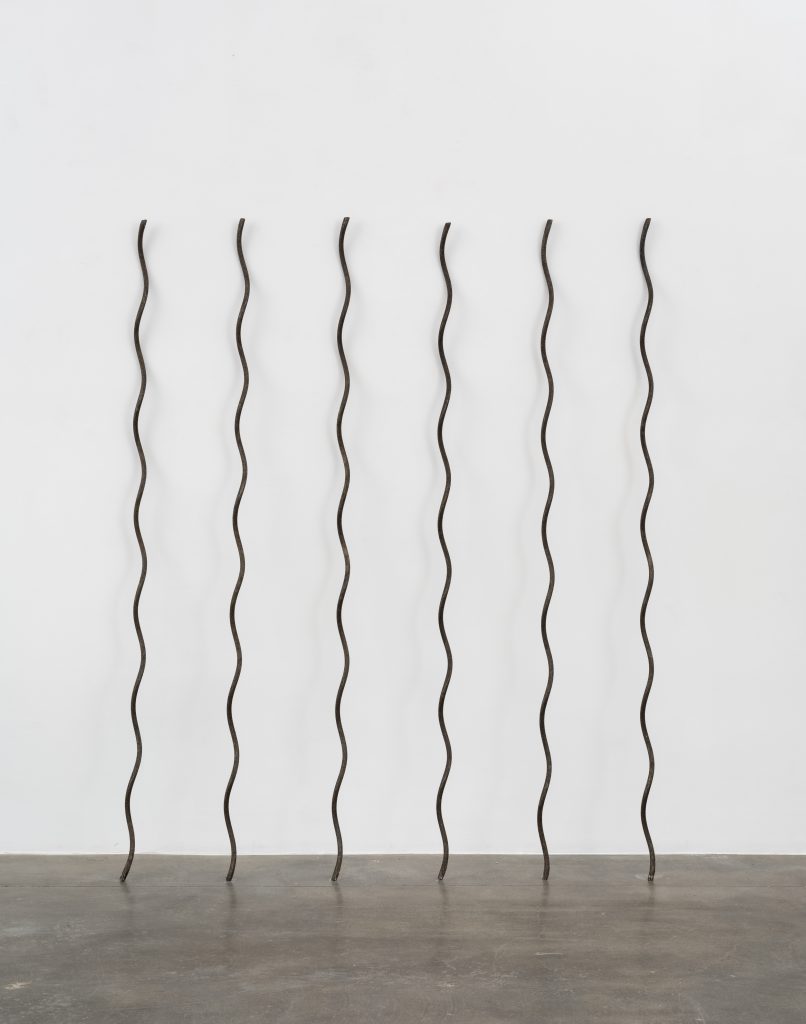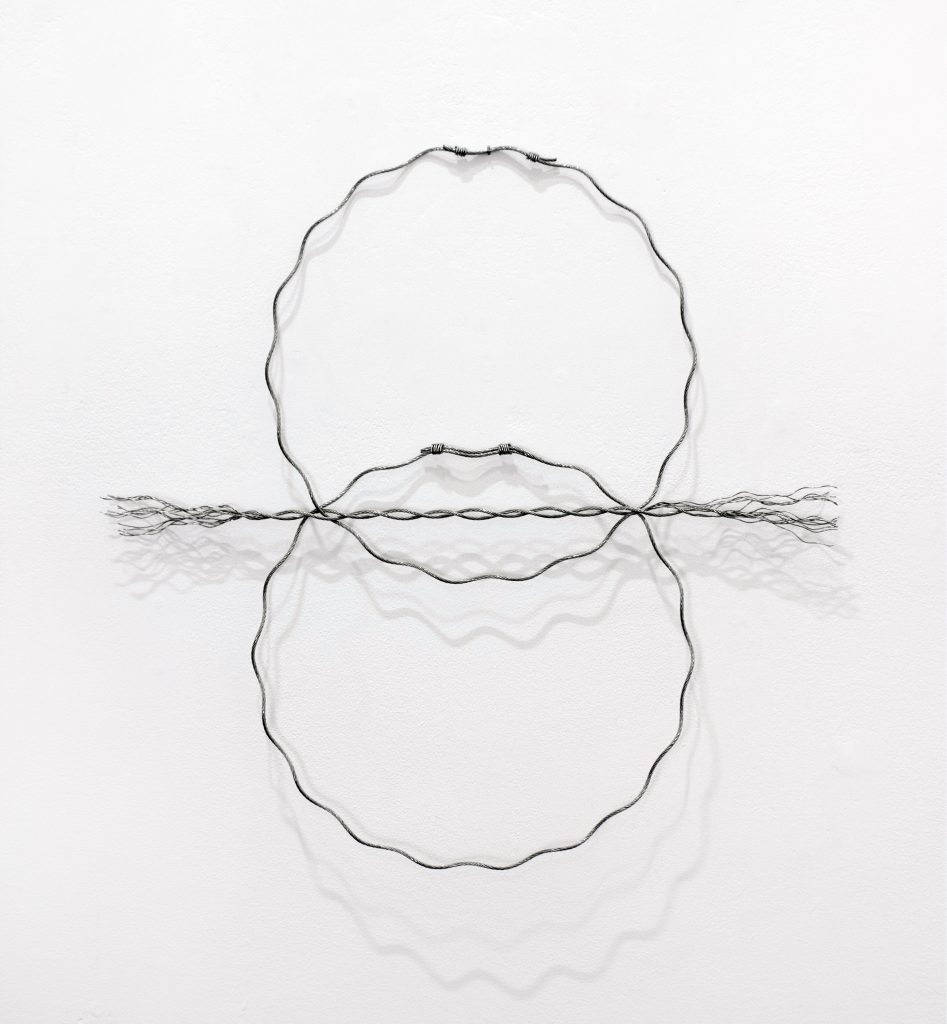I was excited to see the artworks by Maren Hassinger in a new exhibition at Susan Inglett Gallery in New York.
Though the materials of her showcased sculptural works, including steel and concrete, are sometimes known as harsh and off-putting, or at least cold, they’re not here. The artworks — largely abstract, though still evocative and emotionally descriptive — are instead inviting and welcoming, forms that flow as though they’re somehow reaching out to you and whatever is beyond you, though they do not directly encapsulate the precise specifics of something like that. They are, again, quite abstract. But still, they emphasize that feeling.
Both in how they progress through space and in the overall, aesthetic impression they leave, the entrancing artworks approximate features of the natural world, like the flow of water or even the movement of light — the latter something we might take for granted but that bears its own quavering, shimmering nuance when we’re in the midst of it or if you think back on it. And that’s artistically present here.
“Falls I” and “Falls II,” both from 2025, each consist of galvanized wire rope and galvanized steel wire, twisted smoothly together and leaning against the wall — like sculptural, tangible images or parallels of the movement of a waterfall, which I’d imagine is exactly the kind of thing that Hassinger was going for. The image — a reflection that’s evocative of but separate from the original thing; in this case, a real-world flow of water — becomes its own inhabited place, even as the open-ended forms seem to also look and direct our attention outside of themselves and their boundaries. The artworks blend the temporary, delicate, and fleeting with the assertive and lasting, though I can’t help but get the feeling that what lasts in these evoked instances is something persistently distinct from the substance of the original component in the parallel.
In other words, it’s no longer only about the physical specifics of what came first and what we encounter elsewhere in what the art is paralleling: bodies of water, forests, and those living within and with them. Here, their impression remains beyond their physical substance. What we’re looking at is leaving us while we’re looking at it but simultaneous with something greater. Though nature is full of, by default, physical death, there is a tale — an arc — that transcends that, and it’s present even in the comparatively brief sensory encounters of each of Hassinger’s exhibited artworks. There’s a feeling of community and of actual, direct bonds.
Across the exhibition, the artworks feel distinctly light, a sense consistent enough to become truly enveloping and sweeping, like the nature of actual, experienced light in the external, physical world. Here, light manifests as a guide for the construction of real, experienced, spatial progression outside of singular, individualizing confines. The forms of Hassinger’s artworks set up cohesion across and outside of themselves, together melding with an elucidation of place that they carry in any particular location. Place and, specifically, immersion within the natural world that Hassinger’s artwork brings to mind become a story rather than a logistical box. And the story — the free-flowing but inwardly connected movement from place to place encapsulated within each artwork and across the exhibition— becomes gravitational and striking.
In each instance, Hassinger’s art looks like it’s becoming more than itself in real time, while we’re looking at it. In the art’s persistently constructive world, even the act of looking itself — even just standing in front of the artworks and taking them in — feels like it makes you part of an active, ongoing, upwardly or at least outwardly moving spiral of creation.
Though the artworks flow along with quiet, assuring majesty, they’re not closed off. They allow for duality and multiplicity existing truly outside of anything specific or precise. But they do not fade. Concrete, steel, and the ultimate cohesion of Hassinger’s artistic forms ensure you do not get the impression they are fading. These places and experiences remain intact and perceptible even in this sweeping, changing form.
The forms themselves are outside of themselves while they’re right there in front of us, visiting and observing. They are assertive and point to something new that you end up feeling like is already here, within the individual artworks and across the exhibition as a whole. And the relentless smoothness of Hassinger’s sculptural forms, which draws you in, makes the newness feel like it’s in turn renewed every time you look up. The world of Hassinger’s showcased artworks — a world extending beyond their confines — is somewhere I’d want to be, and a place I can actually access.
This exhibition of Maren Hassinger continues at Susan Inglett Gallery through April 26. Thank you to the gallery for helping set up this article.



Featured image: Maren Hassinger, Installation view, Susan Inglett Gallery, NYC (20 March — 26 April 2025) Photo: Adam Reich, Courtesy of Susan Inglett Gallery, NYC.
You may also like
-
Diana Kurz at Lincoln Glenn in New York: A Review of a Shining Art Exhibition
-
Dustin Hodges at 15 Orient in New York City: An Ensnaring Exhibition at an Exciting Gallery
-
Enzo Shalom at Bortolami in New York City: Reviewing an Entrancing Exhibition of Paintings
-
“Ben Werther: Townworld” at Amanita in New York City: Reviewing a Richly Memorable Art Exhibition
-
Carolina Jiménez: “All That We Carry” at HESSE FLATOW in New York: Reviewing a Stirring Textile Art Show
